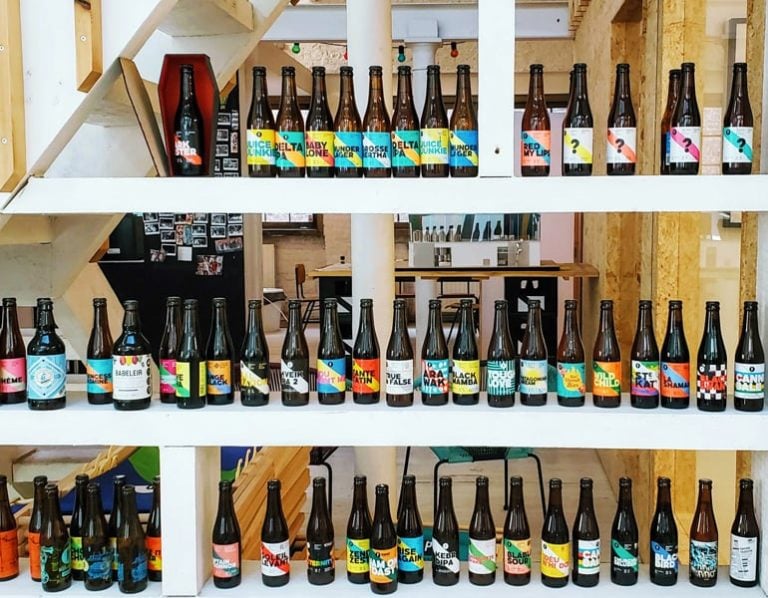Kellerbier and Gose
Kellerbier When you think of a lager, you’ll generally think of an exceedingly mild, crisp…

Kellerbier
When you think of a lager, you’ll generally think of an exceedingly mild, crisp and clear beer. However, there’s a style of lager that kicks these expectations right out of the mash. Kellerbiers are typically unfiltered, unpasteurized lagers born of deep German tradition – the name translates directly to “cellar beer,” as the beer would be served fresh directly from the lagering cellars or caves beneath breweries.
Were the beer lagered further, it would likely become a Munich Helles or Marzen, depending on the malt bill. Today, the BJCP delineates these sub-styles as Pale and Amber Kellerbier.
![]()
As with most lagers, the alcohol range is mild, varying from 4.7% to 5.4% ABV, though characteristics such as color and mouthfeel vary depending on the base style. Compared to the average lager, kellerbiers can be expected to have a slightly creamier texture due to yeast character, which also manifests itself in inoffensive flavor notes of sulfur and diacetyl. The latter can also contribute to a slicker mouthfeel, and the mild level of attenuation also creates a softer, more gently carbonated beer.
Flavor profiles vary with base style, but benchmarks include a grainy, sweet and lightly malty base with low to moderate Noble hop presence, combining for a finish that, while crisp, dry and sometimes bitter, is always tempered by maltiness and the rounded character from yeast.
There’s also much tradition in when and how kellerbier is served. In the 19th century, a kellerbier was any strong beer aged in and served directly from rock cellars. As refrigeration became commonplace, the phrase evolved to special beers served young, directly from the lagering vessel or cellar. As such, though bottled or canned versions do exist, this style is made for draft.
The customs associated with kellerbier are still in place today, especially around Munich and its surrounding areas. Alternate names for kellerbier stem from such traditions – Naturtrüb, or naturally cloudy, and Zwickelbier, which refers to the name of the tap used to sample from the lagering tank.
It should be noted that kellerbier is a fluid term – it describes more the aging and serving processes than specific stylistic requirements. The BJCP allows for multiple styles, such as Pils, Bock or Schwarzbier to be entered as Kellerbier for competition, provided the entry includes a style description for judges.
The sum of the whole is a pleasant, flavorful lager perfectly poised for a rise in popularity, as palates return to favor the nuances of a lager with a little more character and body than the average lawnmower beer.
Pale Kellerbier
Vital Statistics:
OG: 1.045 – 1.051
IBUs: 20 – 35
FG: 1.008 – 1.012
SRM: 3 –7
ABV: 4.7 – 5.4%
Commercial Examples: (local) Paulaner, Paulaner Brauhaus, Hofbrau, Tegernseer Tal. (bottled) Ayinger Kellerbier, Hacker-Pschorr Munchner Kellerbier Anno 1417, Summit 30th Anniversary Keller Pils
Amber Kellerbier
Vital Statistics:
OG: 1.048 – 1.054
IBUs: 25 – 40
FG: 1.012 – 1.016
SRM: 7 – 17
ABV: 4.8 – 5.4%
Commercial Examples: (local) Greif, Eichhorn, Nederkeller, Hebendanz (bottled) Buttenheimer Kaiserdom Kellerbier, Mahr’s Kellerbier, Green Flash Sea to Sea Zwickel Lager
Gose
Gose (pronounced go-zuh), is another style rooted in German tradition that has found a firm foothold in the hearts and palates of modern connoisseurs. The bright, refreshing Gose style began in Goslar, Germany, where minerals from the nearby Harz Mountains provided the River Gose with a tangy, mineral quality that the locals described as “copper water.”
![]()
This water provided the base for what would become Gose, a spritzy, tart and salty beverage spiced with coriander that had the Bavarian region of Saxony buzzing as far back as 1239, the year of the first recorded mention of Gose from one Duke Otto von Braunschweig.
Stylistic hallmarks include noticeable, but balanced lacto acidity, wheaty to doughy malt character, moderate notes of stone or citrus fruits with a light body and dry finish, often punctuated with tartness.
This rollercoaster ride for the tastebuds was especially hot in Leipzig, capital of the German state of Saxony where, at the height of its popularity, at least 80 licensed Leipziger Gose houses served the briny suds. Things were groovy for Gose from 1738 until the early 20th century, when Germany’s geopolitical affairs detracted from time that might have otherwise been spent enjoying this delightfully sour concoction.
By the end of World War II, the last remaining Gose brewery had ceased production, and save for one small brewer in Leipzig from 1949 to 1966, the venerable Gose had ceased to be, and it took twenty years for a man named Lothar Goldhahn to revive the style at the Schultheiss Weissbier brewery.
Decades later, Gose has finally regained its stature both in Germany and America, where brewers are exploring piquant variations on the theme, adding all manner of adjuncts including lime, cucumber, blood orange, watermelon and blackberries. The Aloha Beer Company even experimented with seawater as a liquor for brewing Gose.
Similar to a Berliner Weisse, Gose is ripe for blending. It can be sweetened with syrups, or fortified with various liqueurs, and pairs well with robust seafood flavors like smoked salmon or oysters.
No longer an obscurity, Gose is gaining popularity as an easily palatable brew suitable for almost any occasion. Whether served in its traditional stange or a can, it remains a living piece of history perhaps more relevant than ever before.
Vital Statistics:
OG: 1.036 – 1.056
IBUs: 5 – 12
FG: 1.006 – 1.010
SRM: 3 – 4
ABV: 4.2 – 4.8%
Commercial Examples: Anderson Valley Gose, Bayerisch Bahnhof Leipziger Gose, Döllnitzer Ritterguts Gose, Uinta Ready Set Gose, DESTIHL Here Gose Nothin’, FATE Uror, Westbrook Gose, Sixpoint Jammer
Photo courtesy Flickr/Bernt Rostad.
















Comments 0
No Readers' Pick yet.